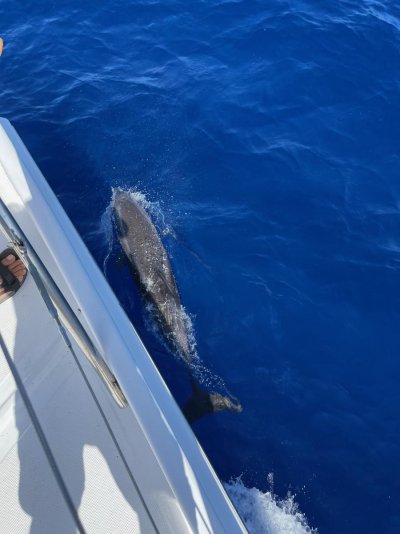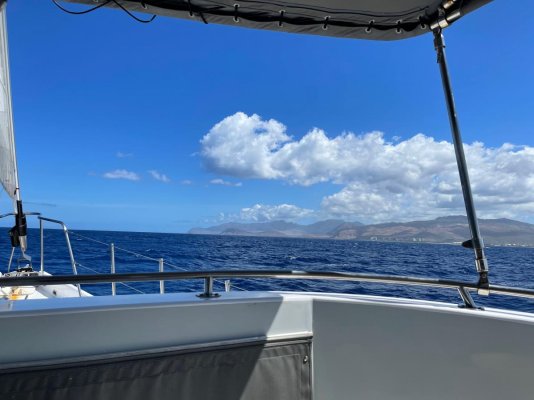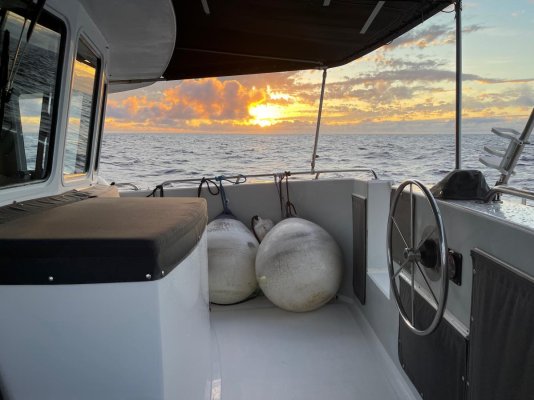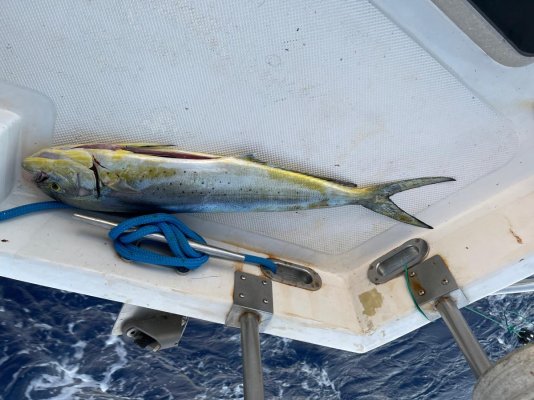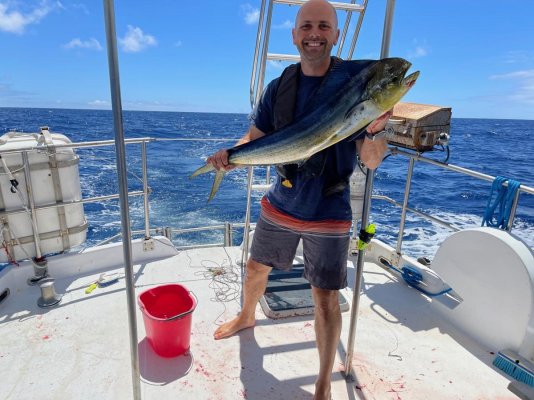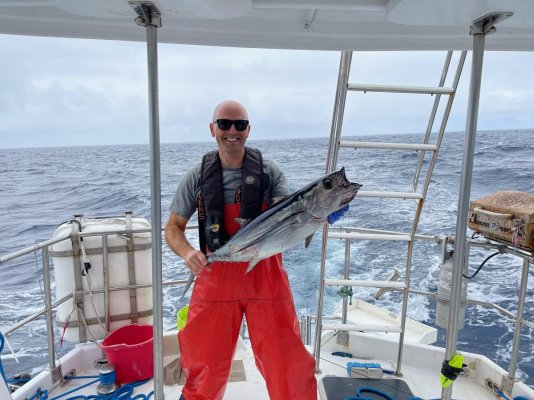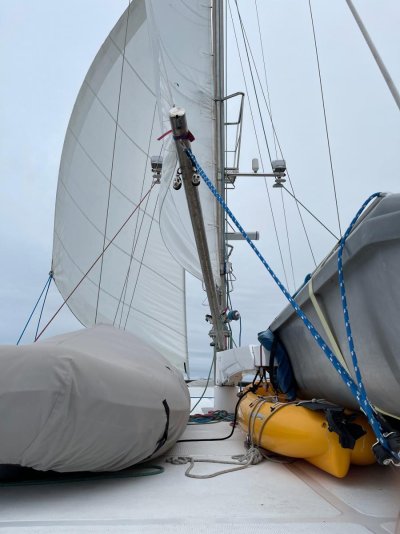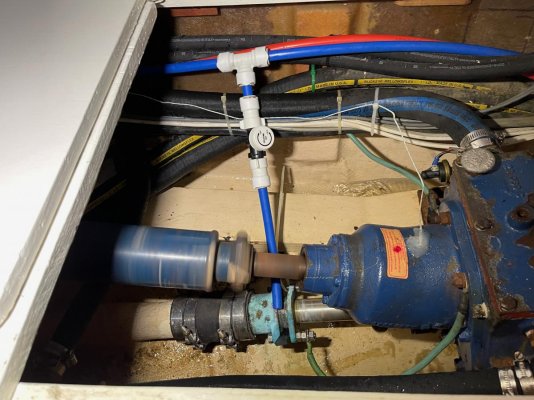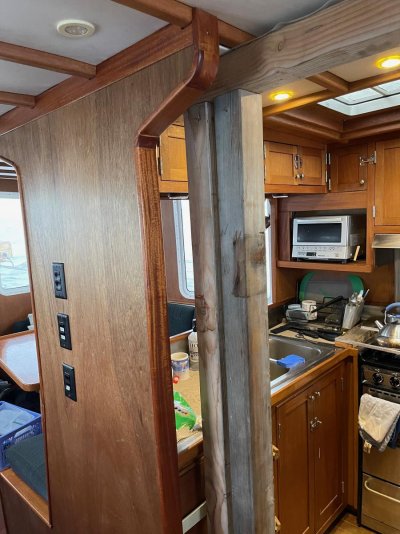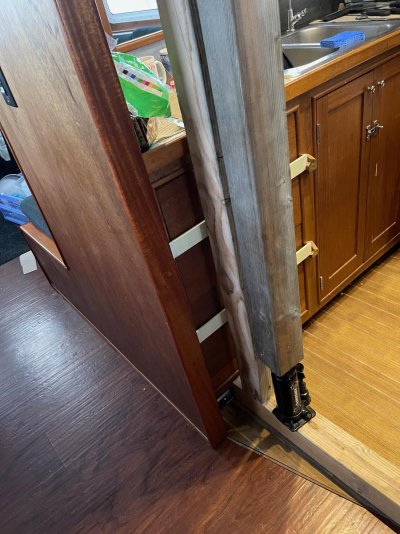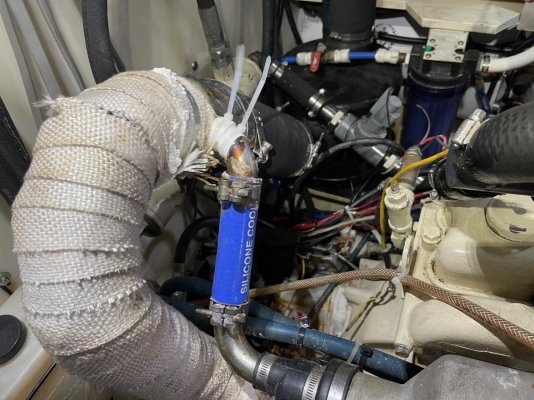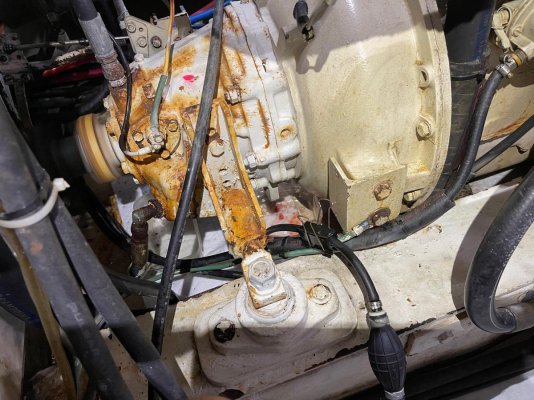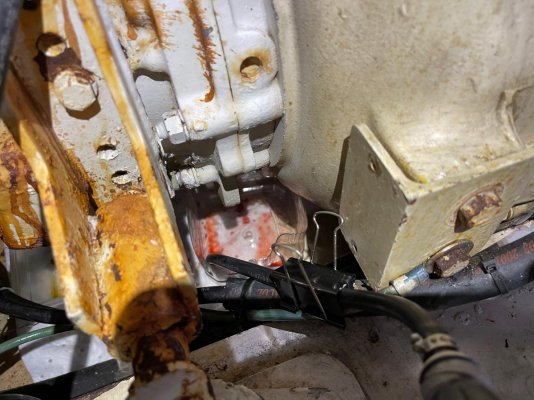You are using an out of date browser. It may not display this or other websites correctly.
You should upgrade or use an alternative browser.
You should upgrade or use an alternative browser.
I bought a boat in Fiji sight unseen!
- Thread starter Snapdragon III
- Start date
The friendliest place on the web for anyone who enjoys boating.
If you have answers, please help by responding to the unanswered posts.
If you have answers, please help by responding to the unanswered posts.
RedRascal
Senior Member
I've been checking on Snap Dragon's progress now and then, it looks like they may get to Washington waters on Saturday. Quite the shakedown cruise for a new to you boat.
https://forecast.predictwind.com/tracking/display/SnapDragon
https://forecast.predictwind.com/tracking/display/SnapDragon
Last edited:
- Joined
- May 11, 2019
- Messages
- 3,670
- Location
- United States
- Vessel Name
- Muirgen
- Vessel Make
- 50' Beebe Passagemaker
looks like they're coming up abreast of Port Angeles now, almost to their new home in Anacortes!
Snapdragon III
Senior Member
- Joined
- Sep 1, 2016
- Messages
- 457
- Location
- Anacortes, WA
- Vessel Name
- Snapdragon
- Vessel Make
- Custom 56' Skookum trawler
Made it in safely to Anacortes yesterday afternoon. We had a mostly great trip. The crew was great, the boat did fundamentally great, with some mechanical drama we had to deal with. The weather beat us up for the first five or six days of strong headwinds, but was great after that. The fishing was outstanding. I will write up a more comprehensive account of some of the highlights, and the problems we had out there in a few days once things settle down at home.
- Joined
- Aug 29, 2012
- Messages
- 2,691
- Location
- Good Ol' US of A!
- Vessel Name
- Pau Hana
- Vessel Make
- 1989 PT52 Overseas Yachtfisher
Made it in safely to Anacortes yesterday afternoon. We had a mostly great trip. The crew was great, the boat did fundamentally great, with some mechanical drama we had to deal with. The weather beat us up for the first five or six days of strong headwinds, but was great after that. The fishing was outstanding. I will write up a more comprehensive account of some of the highlights, and the problems we had out there in a few days once things settle down at home.
Welcome home!
OldDan1943
Guru
- Joined
- Oct 2, 2017
- Messages
- 10,656
- Location
- USA
- Vessel Name
- Kinja
- Vessel Make
- American Tug 34 #116 2008
Fantastic!!! Everyone is safe and well fed.
It's great you and the crew were able to overcome those mechanical problem.
Now you have a better idea on what spare parts and general stores should be carried on board.
A. more toilet paper. CHUCKLE
It's great you and the crew were able to overcome those mechanical problem.
Now you have a better idea on what spare parts and general stores should be carried on board.
A. more toilet paper. CHUCKLE
IRENE
Guru
- Joined
- Jan 8, 2016
- Messages
- 1,254
- Location
- British Columbia
- Vessel Name
- Irene
- Vessel Make
- Nordhavn 40II
Well done! We enjoyed following your trip, and very much look forward to your next write up. Thank you for sharing.
Comodave
Moderator Emeritus
- Joined
- Jul 2, 2015
- Messages
- 22,445
- Location
- Au Gres, MI
- Vessel Name
- Black Dog
- Vessel Make
- Formula 41PC
What a trip. Congrats.
- Joined
- May 11, 2019
- Messages
- 3,670
- Location
- United States
- Vessel Name
- Muirgen
- Vessel Make
- 50' Beebe Passagemaker
I had your predict winds saved on my tab bar. I checked it in the AM when I got up, and generally once when in the evening. Interesting that your speed occasionally showed 0, sometimes 3, generally 6 to 8, and one time I saw 19.4 kts! Glad you made it home safe, and have a freezer of fish for you wife! Welcome home, and looking forward to hearing specifics about the trip.
OldDan1943
Guru
- Joined
- Oct 2, 2017
- Messages
- 10,656
- Location
- USA
- Vessel Name
- Kinja
- Vessel Make
- American Tug 34 #116 2008
One heck of a sea trial.
Snapdragon III
Senior Member
- Joined
- Sep 1, 2016
- Messages
- 457
- Location
- Anacortes, WA
- Vessel Name
- Snapdragon
- Vessel Make
- Custom 56' Skookum trawler
Over all this trip went really well. I am going to post on some of the drama we had, in subsequent posts because I think it is interesting to hear about for others thinking about this type of trip, but I don't want to give the impression that it was a miserable, dangerous trip. The boat did great, and I could not have been happier with the crew we had on board. We had myself, The Delivery Capitan, Ronnie and Engineer, Graham, that I hired in Fiji to bring the boat from Fiji to Hawaii, who were both great guys, and are now friends, and Jim, who is also a Trawler forum member, (user name "Divealot"). To be honest I wanted to do the trip with just 3 people, but the only insurance I could find required 4. I had met Jim, but did not know him at all, but heard through the grapevine that he was interested. I was nervous setting out on a trip like this with someone I didn't know, but he turned out to be great, and I now consider him a friend as well. Having 4 on board made the watch keeping very easy, as each of us only had 2, 3 hour watches per day. It was nice that the boat was big enough that each of us essentially had our own bedroom so we all has some semi private space to hang out, and sleep.
We knew we were going to see some rough weather leaving Hawaii, and it did not disappoint. About the first 5 days we were heading into the wind that was steadily between 15-25MPH, with gusts at times into the low 30's. If I were to do this trip again with the family, I would definitely wait for a better weather window, but with 4 different crew members that all had obligations to get back to after the trip, we just went for it, as we felt is was safe, just uncomfortable. The other part of the decision was that the long range forecast looked really good, after the initial rough days, and that part came true and we had great weather for the rest of the trip. Not much sun, but light, or following winds, and we did not get beat up at all by NW winds when we came into the Washington coast, which I was worried about, and had experienced the last time I did this trip on a sailboat back in 1998.
The boat was ok, but it was tough on us humans inside. It was particularly hard to cook and eat anything. Opening the refrigerator was horrible. It is a small home style LG 120v fridge that was completely packed at the beginning of the trip. When you opened it, things would immediately start falling out, then you would let go of the door to try and catch them, then the door would swing around wildly and dump more stuff, and try and break itself off. It sucked. It was easier with two people if the second person was there to hold the door, while the first person got food out. Another thing that would have helped a lot in hindsight would have been to line all the shelves in the fridge with foam nonskid mesh before loading it, so stuff wouldn't slide around so much. The upside was that 3 of the 4 of us were slightly queasy to varying degrees from all the motion, and eating didn't seem all that appealing anyways. I remember feeling like it was a huge accomplishment making myself a couple pieces of peanut butter toast the second day out. It was also pretty hot and humid in the boat as beating into the wind required all the hatches and doors to be closed to keep out the salt water spray. The boat had 12v air conditioning but we were nervous about running it as we hadn't really tested it running off the alternator power, and were worried about burning up the alternator early in the trip.
We used the mainsail on the boat during the rough early part of the trip and it definitely added some stability, and a little bit of speed, but also led to some problems as I will detail later. The stabilizers were helpful too, but you definitely paid a price in boat speed while using them, especially at the higher gain settings. We ended up having them set on low to medium gain most of the trip, as an extra, 0.5-0.7kn of boat speed really adds up when you have 2500 miles to go. Even with the gain cranked up to 100 it was still super bouncy inside the boat since we were going up wind in substantial waves, and there was a ton of hobby horsing which was not helped by the stabilizers. Given the conditions, I can not imagine it being much more comfortable in any other boat that would be of a size I would feel comfortable running myself. While the conditions the first few days were miserable, I kind of liked it, as it was a great chance to see how my new boat handled it, without my family on board, and I am now much more confident in the boat than I had been previously.
After the weather calmed down things settled down into a pretty boring, But pleasant routine. Other than when I was sleeping, I spent almost all of the trip up in the pilot house with whoever was on watch talking their ears off, and soaking in being out there crossing the Pacific. We made up for lost time and ate very well for the rest of the trip once the weather calmed down. The fishing got good and I caught a ton of Mahi Mahi, probably around 20 total, Then there was a day or two of no fish, followed by Albicore tuna, which I caught about a dozen of, but finally quit fishing as I was running out of freezer space for the filets, and I was tired of processing them. I came back with a small chest freezer full of fillets for my wife, and we also ate lots of fish along the way. We caught them all on hand lines, with huge rubber hoochies.
I don't have the exact trip specs on hand at home but I think it was about 17 1/2 days, a little over 2500 miles. I will look up the exact fuel usage when I get back to the boat but we burned around 1300 gallons, and averaged a little over 1.9miles per gallon. During the first part of the trip when we were beating into the wind we were getting about 1.5mpg, and speeds in the low 5's, and at the end with calm or following seas we were more in the high 6's and getting up to 2.3mpg. There were short periods where we were able to use the sails downwind where we were in the mid 7's, but as I will outline later the sails were mostly a disappointment.
We knew we were going to see some rough weather leaving Hawaii, and it did not disappoint. About the first 5 days we were heading into the wind that was steadily between 15-25MPH, with gusts at times into the low 30's. If I were to do this trip again with the family, I would definitely wait for a better weather window, but with 4 different crew members that all had obligations to get back to after the trip, we just went for it, as we felt is was safe, just uncomfortable. The other part of the decision was that the long range forecast looked really good, after the initial rough days, and that part came true and we had great weather for the rest of the trip. Not much sun, but light, or following winds, and we did not get beat up at all by NW winds when we came into the Washington coast, which I was worried about, and had experienced the last time I did this trip on a sailboat back in 1998.
The boat was ok, but it was tough on us humans inside. It was particularly hard to cook and eat anything. Opening the refrigerator was horrible. It is a small home style LG 120v fridge that was completely packed at the beginning of the trip. When you opened it, things would immediately start falling out, then you would let go of the door to try and catch them, then the door would swing around wildly and dump more stuff, and try and break itself off. It sucked. It was easier with two people if the second person was there to hold the door, while the first person got food out. Another thing that would have helped a lot in hindsight would have been to line all the shelves in the fridge with foam nonskid mesh before loading it, so stuff wouldn't slide around so much. The upside was that 3 of the 4 of us were slightly queasy to varying degrees from all the motion, and eating didn't seem all that appealing anyways. I remember feeling like it was a huge accomplishment making myself a couple pieces of peanut butter toast the second day out. It was also pretty hot and humid in the boat as beating into the wind required all the hatches and doors to be closed to keep out the salt water spray. The boat had 12v air conditioning but we were nervous about running it as we hadn't really tested it running off the alternator power, and were worried about burning up the alternator early in the trip.
We used the mainsail on the boat during the rough early part of the trip and it definitely added some stability, and a little bit of speed, but also led to some problems as I will detail later. The stabilizers were helpful too, but you definitely paid a price in boat speed while using them, especially at the higher gain settings. We ended up having them set on low to medium gain most of the trip, as an extra, 0.5-0.7kn of boat speed really adds up when you have 2500 miles to go. Even with the gain cranked up to 100 it was still super bouncy inside the boat since we were going up wind in substantial waves, and there was a ton of hobby horsing which was not helped by the stabilizers. Given the conditions, I can not imagine it being much more comfortable in any other boat that would be of a size I would feel comfortable running myself. While the conditions the first few days were miserable, I kind of liked it, as it was a great chance to see how my new boat handled it, without my family on board, and I am now much more confident in the boat than I had been previously.
After the weather calmed down things settled down into a pretty boring, But pleasant routine. Other than when I was sleeping, I spent almost all of the trip up in the pilot house with whoever was on watch talking their ears off, and soaking in being out there crossing the Pacific. We made up for lost time and ate very well for the rest of the trip once the weather calmed down. The fishing got good and I caught a ton of Mahi Mahi, probably around 20 total, Then there was a day or two of no fish, followed by Albicore tuna, which I caught about a dozen of, but finally quit fishing as I was running out of freezer space for the filets, and I was tired of processing them. I came back with a small chest freezer full of fillets for my wife, and we also ate lots of fish along the way. We caught them all on hand lines, with huge rubber hoochies.
I don't have the exact trip specs on hand at home but I think it was about 17 1/2 days, a little over 2500 miles. I will look up the exact fuel usage when I get back to the boat but we burned around 1300 gallons, and averaged a little over 1.9miles per gallon. During the first part of the trip when we were beating into the wind we were getting about 1.5mpg, and speeds in the low 5's, and at the end with calm or following seas we were more in the high 6's and getting up to 2.3mpg. There were short periods where we were able to use the sails downwind where we were in the mid 7's, but as I will outline later the sails were mostly a disappointment.
Snapdragon III
Senior Member
- Joined
- Sep 1, 2016
- Messages
- 457
- Location
- Anacortes, WA
- Vessel Name
- Snapdragon
- Vessel Make
- Custom 56' Skookum trawler
Snapdragon III
Senior Member
- Joined
- Sep 1, 2016
- Messages
- 457
- Location
- Anacortes, WA
- Vessel Name
- Snapdragon
- Vessel Make
- Custom 56' Skookum trawler
OldDan1943
Guru
- Joined
- Oct 2, 2017
- Messages
- 10,656
- Location
- USA
- Vessel Name
- Kinja
- Vessel Make
- American Tug 34 #116 2008
How far off the wind could you sail?
Snapdragon III
Senior Member
- Joined
- Sep 1, 2016
- Messages
- 457
- Location
- Anacortes, WA
- Vessel Name
- Snapdragon
- Vessel Make
- Custom 56' Skookum trawler
How far off the wind could you sail?
It sailed best about 90 to 135 degrees off the wind. The headsail sheets are rigged through blocks at the end of the old stabilizer poles, and in theory they should be able to be lowered and hold the sail open like a wisker pole for sailing dead down wind. In practice there is not an effective way to hold the poles down, and they flop up and down as the sail fills and collapses as the boat rolls.
Snapdragon III
Senior Member
- Joined
- Sep 1, 2016
- Messages
- 457
- Location
- Anacortes, WA
- Vessel Name
- Snapdragon
- Vessel Make
- Custom 56' Skookum trawler
Moving on to some of the issues we had, here is a list in order in increasing severity, not chronological. Almost all of these are things that I easily would have caught and fixed if I had bought the boat under different circumstances and had a chance to do some weekend shakedown cruising on it before taking off on such a huge trip.
1. Choppy, inconsistent GPS tracking page that freaked everyone back home out for no reason.
2. Bad connection on ethernet cable on Simrad radar that cased it to not work consistently.
3. Starboard engine ran consistently hotter than port and was burning much more fuel.
4. Port stuffing box stopped dripping and would not drip even after extreme loosening.
5. Deforming deck/maststep. Poorly engineered sailing rig.
6. Leaking exhaust wet elbow leading to transmission problems.
1. GPS track. I knew going into this trip that the GPS tracking page provided by Predict wind, using the Iridium GO unit had an annoying choppy track. After much research when the boat was coming up from Fiji to Hawaii, I determined that the cause was poor GPS reception inside the boat, that led to inaccurate positions. The unit has an external antenna, but apparently that antenna only is for communication with the Iridium satellites, and even with it, the unit still relies on it's internal GPS for it's position. The position it spits out when mounted in my boat is only accurate to a couple miles. You can clearly see this if you zoom in on the boat when it was at the dock in Hawaii. It looks like it was bouncing all over the place. This leads to a super choppy track, and speeds that are all over the place. What I did not know till I got home, was that on a few occasions it stopped updating the track all together, causing a bunch of friends and family to worry that something was wrong, because it showed boat speed as zero. We did not even know it was happening, but there were a few times that the software on the unit seemed to crash, and we had to restart it to get text messages and weather updates to work. I suspect these were the times when it stopped updating. Very minor, but if I had known what was going on, I would have let people know so they wouldn't worry. In reality we only stopped the boat once during the trip for about an hour to change the oil in both engines. We decided to just shut them both down, since it was so much quieter, and cooler in the engine room to do it that way.
2. Bad connection on Simrad radar ethernet cable. The boat came with a fairly new Simrad MFD, and a brand new top of the line Simrad open array radar. Unfortunately it was completely broken on the trip from Hawaii to Fiji. When the boat was in Hawaii I messed around with it and got it working. I traced the problem down to an ethernet cable that at the time I thought had just come loose. I thought I had fixed the problem. That was 6 months ago. This trip we did a short few hour shake down cruise a few days before we left, and the radar started right up, but shut back down after about 15 minutes. I messed with the ethernet cable some more and got it working again, but it kept shutting off at random times. I tried to buy a new cable at West Marine the next day, but they didn't have the right one, so I got a can of contact cleaner instead. I messed with the cable and attempted to clean the contacts a ton more, and got it mostly working, but it would still shut off every once in awhile. We finally gave up on it as there were almost no ships out there anyways, and the ones that were around showed up on our AIS system way before radar could pick them up anyways. As we approached the Washington coast about 250 miles out we came across a few trawlers that were fishing, and not broadcasting AIS. (I suspect they were fishing a temp change line for Albicore.). We easily avoided them, but as the weather was rainy and grey, and it was getting dark soon it seemed more pressing to get the radar working better. I messed with it a bunch more, and finally came to the conclusion that I might have been concentrating my efforts on the wrong end of the faulty ethernet cable. I think in the end the bad connection was where the cable met the MFD, not the end where it met the radar box as I had thought. It was so intermittent, it was hard to track down. I have always been doubtful that contact cleaner does anything, but in this case it seemed to help. The radar worked good for the rest of the trip, and we were glad to have it coming in to Cape Flattery as there was tons of commercial, fishing, pilot boat, etc traffic out there, and it was dark and raining. On a separate note, AIS is the best. What a great piece of safety gear for the price. In every case where we got close to a fast moving freighter it seemed likely that they had seen us on the AIS an altered their coarse just slightly to pass us safely. We never had do call any of them on the VHF as the AIS, and projected coarse of both boats made it clear we were going to pass safely.
1. Choppy, inconsistent GPS tracking page that freaked everyone back home out for no reason.
2. Bad connection on ethernet cable on Simrad radar that cased it to not work consistently.
3. Starboard engine ran consistently hotter than port and was burning much more fuel.
4. Port stuffing box stopped dripping and would not drip even after extreme loosening.
5. Deforming deck/maststep. Poorly engineered sailing rig.
6. Leaking exhaust wet elbow leading to transmission problems.
1. GPS track. I knew going into this trip that the GPS tracking page provided by Predict wind, using the Iridium GO unit had an annoying choppy track. After much research when the boat was coming up from Fiji to Hawaii, I determined that the cause was poor GPS reception inside the boat, that led to inaccurate positions. The unit has an external antenna, but apparently that antenna only is for communication with the Iridium satellites, and even with it, the unit still relies on it's internal GPS for it's position. The position it spits out when mounted in my boat is only accurate to a couple miles. You can clearly see this if you zoom in on the boat when it was at the dock in Hawaii. It looks like it was bouncing all over the place. This leads to a super choppy track, and speeds that are all over the place. What I did not know till I got home, was that on a few occasions it stopped updating the track all together, causing a bunch of friends and family to worry that something was wrong, because it showed boat speed as zero. We did not even know it was happening, but there were a few times that the software on the unit seemed to crash, and we had to restart it to get text messages and weather updates to work. I suspect these were the times when it stopped updating. Very minor, but if I had known what was going on, I would have let people know so they wouldn't worry. In reality we only stopped the boat once during the trip for about an hour to change the oil in both engines. We decided to just shut them both down, since it was so much quieter, and cooler in the engine room to do it that way.
2. Bad connection on Simrad radar ethernet cable. The boat came with a fairly new Simrad MFD, and a brand new top of the line Simrad open array radar. Unfortunately it was completely broken on the trip from Hawaii to Fiji. When the boat was in Hawaii I messed around with it and got it working. I traced the problem down to an ethernet cable that at the time I thought had just come loose. I thought I had fixed the problem. That was 6 months ago. This trip we did a short few hour shake down cruise a few days before we left, and the radar started right up, but shut back down after about 15 minutes. I messed with the ethernet cable some more and got it working again, but it kept shutting off at random times. I tried to buy a new cable at West Marine the next day, but they didn't have the right one, so I got a can of contact cleaner instead. I messed with the cable and attempted to clean the contacts a ton more, and got it mostly working, but it would still shut off every once in awhile. We finally gave up on it as there were almost no ships out there anyways, and the ones that were around showed up on our AIS system way before radar could pick them up anyways. As we approached the Washington coast about 250 miles out we came across a few trawlers that were fishing, and not broadcasting AIS. (I suspect they were fishing a temp change line for Albicore.). We easily avoided them, but as the weather was rainy and grey, and it was getting dark soon it seemed more pressing to get the radar working better. I messed with it a bunch more, and finally came to the conclusion that I might have been concentrating my efforts on the wrong end of the faulty ethernet cable. I think in the end the bad connection was where the cable met the MFD, not the end where it met the radar box as I had thought. It was so intermittent, it was hard to track down. I have always been doubtful that contact cleaner does anything, but in this case it seemed to help. The radar worked good for the rest of the trip, and we were glad to have it coming in to Cape Flattery as there was tons of commercial, fishing, pilot boat, etc traffic out there, and it was dark and raining. On a separate note, AIS is the best. What a great piece of safety gear for the price. In every case where we got close to a fast moving freighter it seemed likely that they had seen us on the AIS an altered their coarse just slightly to pass us safely. We never had do call any of them on the VHF as the AIS, and projected coarse of both boats made it clear we were going to pass safely.
Last edited:
Snapdragon III
Senior Member
- Joined
- Sep 1, 2016
- Messages
- 457
- Location
- Anacortes, WA
- Vessel Name
- Snapdragon
- Vessel Make
- Custom 56' Skookum trawler
3. Starboard engine ran consistently hotter than port, and was burning about 25% more fuel. I knew the starboard engine had run hotter on the trip up from Fiji, but after discovering the heat exchangers in the V drives, were packed full of rust, (As outlined in an earlier post) I had hoped it was due to a restriction in the flow of cooling water, and we had fixed it. That turned out not to be the case, and the Starboard engine was still running hotter. The block was about 10-15 degrees hotter, and the exhaust was way hotter. The exhaust on Starboard was about 700F most of the trip, and the Port was only 500-500F. I had looked up acceptable exhaust gas temperatures before we left and those both seemed well within the acceptable range, so I didn't worry too much about it, but it still bothered me. Then awhile into the trip when the boat was a little lighter, and the exhaust ports were closer to the surface of the water I noticed the Starboard engine had darker exhaust than the port. Not crazy black or anything, but definitely darker than the port which was almost clear. At that point I asked Graham, who had been doing the transfers from the main tanks to the day tanks to keep track of how much fuel each engine was using individually, and we discovered that the Starboard was using about 25% more fuel. We never got to the bottom of what is going on. My two theories are that the two sides have different pitch of propellers on them, or possibly that the hydraulic system is misadjusted and all the load is being placed on one engine. I am doubtful of the second theory since I think I understand how to adjust the hydraulic system, and I think it is good. And also because the temps don't even out if you turn off the stabilizers, and hydraulically driven alternator. I will have to investigate further now that I am home. The salt water coming in and out of the heat exchangers on both engines was very similar, so I don't think a restriction in cooling water is causing the difference, and I don't see how that would effect fuel burn anyways.
Snapdragon III
Senior Member
- Joined
- Sep 1, 2016
- Messages
- 457
- Location
- Anacortes, WA
- Vessel Name
- Snapdragon
- Vessel Make
- Custom 56' Skookum trawler
4. We were monitoring temperatures of the V drives, Stuffing boxes, hydraulic pumps, transmissions, engine blocks, engine heat exchangers, hydraulic Tank, alternator, and exhaust, every 4 hours. I had made a spread sheet with empty cells that I printed a bunch of copies of before we left, that we used to record the temp values so we could watch for changes over time. This turned out to be a very good idea as it helped us catch a couple problems before they became potential disasters. About the 4th day out we noticed that the stuffing box on the port shaft had completely stopped dripping and started to heat up very slightly. We figured no problem, and proceeded to loosen the bolts up to get it dripping again. No matter how loose we got it, it would not drip. We kept an eye on it for awhile hoping that it would start dripping again not that we had it super loose, but it didn't. I had a spray bottle I was using to squirt water on it and it seemed to find its way down the inside of it, and run cool and perfectly as long as I gave it a couple squirts an hour. We were pretty sure there was probably extra stuffing on board, as the boat came with a huge inventory of spare parts, but the weather was still pretty rough and we could not find it. I was able to get ahold of the guy I bought the boat from via text on the Iridium, and while not super helpful, at least he was pretty sure there was extra stuffing on board, even though he couldn't remember where it was. That made me feel better. We did a serious search for it, and finally were able to locate replacement stuffing. Having it on hand made me feel much better, although I still was not excited about replacing it out there. I have replaced the stuffing on valve handles on large industrial valves, which is essentially the same system, but I had never done it on a boat in the water, and was not excited to try it for the first time in the middle of the Pacific. Since spraying the outside with water seemed to be working so good, I came up with the idea to tap into a nearby pressurized fresh water line, and run a pipe one that would slowly drip on the stuffing box to cool it. We found the parts, and it worked perfectly. The only thing that was hard was the valve we found was not really intended to be used partially open, and we had a hard time getting a consistent slow drip. We ended up stuffing strips of rags in the upstream side of the valve which helped some. The system worked perfectly for the next 13+ days. The stuffing box stayed cool as a cucumber.
Attachments
Last edited:
Snapdragon III
Senior Member
- Joined
- Sep 1, 2016
- Messages
- 457
- Location
- Anacortes, WA
- Vessel Name
- Snapdragon
- Vessel Make
- Custom 56' Skookum trawler
5. Deforming mast step/cabin top. This one was the most disappointing of the problems we had, and the one with no easy fix now that the boat is home. I had posted back in November when I first got the boat that I discovered that the sailing rig had not been properly engineered when it was added, and the deck was deforming/collapsing significantly under the deck stepped mast. We had loosened up the rig, jacked up the ceiling, and installed some temporary bracing to mitigate the problem for the trip home till a more permanent solution could be found. I did not post here about it, but when I was back working on the boat in February, I met a guy at the yacht club who had a background in wooden boat building, and hired him to remove the side of the existing cabinets near the mast step, and replace it with a structural bulkhead. He did a nice job, and we put in a 2" marine ply bulkhead. It still wasn't ideal as it was lined up with the starboard edge of the mast, not the center, and there was not a perfect load path down below on the lower level either, but it was much better then what was there before, and we were hoping it would be good enough. It turned out not to be good enough and the deck started to sag noticeably on the port side of the mast where is was unsupported from below. Fortunately we had Brough the lumber from the temporary bracing we had made back in November with us just in case, and I still had the hydraulic jack I had purchased on board. We jacked the roof back up, and installed temporary bracing on the port side of the mast, which stabilized it, but blocked access to 4 kitchen drawers. It worked fine the rest of the way home, but we backed off the rig tension as much as we dared to, and took it very easy with the sailing.
Unfortunately I do not see an easy path for fixing the sailing rig. It sucks because it is actually pretty sweet under the right conditions, and the previous owner spent a ton of money setting it up. The problem is that is seems likely that he did not follow the advice of a naval architect, or an experienced sailor for the project. The problems with it are many, the rig is way to heavy being made out of stainless steel pipe, There is not a proper load path to support the deck stepped mast, there are numerous chafe issues with the way it is set up, The mainsail can only be used on starboard tack due to the dingy in the way, The leads for the headsail on the end of the old stabilizer poles don't really work, trimming the sheets for the headsail is done with an electric winch on the back, and you can't see the sail at all when you are using it. Most of these problems could be fixed if you threw enough money and time at it, but it would be a lot of money and time. I just don't see myself using the sails that much, even if they were perfect, so I will probably just end up removing the whole thing and making it a pure power boat, as it was originally. But even that isn't super easy since the mast has the radar, antennas, spotlight, decklights, etc mounted on it. Also the old stabilizer poles are set up to use as flopper stoppers at anchor, but need structure to attach to at the top. The spot where the original support structure was is now occupied by the steelhead crane that was added. There is no easy answer.
Unfortunately I do not see an easy path for fixing the sailing rig. It sucks because it is actually pretty sweet under the right conditions, and the previous owner spent a ton of money setting it up. The problem is that is seems likely that he did not follow the advice of a naval architect, or an experienced sailor for the project. The problems with it are many, the rig is way to heavy being made out of stainless steel pipe, There is not a proper load path to support the deck stepped mast, there are numerous chafe issues with the way it is set up, The mainsail can only be used on starboard tack due to the dingy in the way, The leads for the headsail on the end of the old stabilizer poles don't really work, trimming the sheets for the headsail is done with an electric winch on the back, and you can't see the sail at all when you are using it. Most of these problems could be fixed if you threw enough money and time at it, but it would be a lot of money and time. I just don't see myself using the sails that much, even if they were perfect, so I will probably just end up removing the whole thing and making it a pure power boat, as it was originally. But even that isn't super easy since the mast has the radar, antennas, spotlight, decklights, etc mounted on it. Also the old stabilizer poles are set up to use as flopper stoppers at anchor, but need structure to attach to at the top. The spot where the original support structure was is now occupied by the steelhead crane that was added. There is no easy answer.
Attachments
Since spraying the outside with water seemed to be working so good, I came up with the idea to tap into a nearby pressurized fresh water line, and run a pipe one that would slowly drip on the stuffing box to cool it. We found the parts, and it worked perfectly. The only thing that was hard was the valve we found was not really intended to be used partially open, and we had a hard time getting a consistent slow drip. We ended up stuffing strips of rags in the upstream side of the valve which helped some. The system worked perfectly for the next 13+ days. The stuffing box stayed cool as a cucumber.
Loren:
Is your middle name MacGyver?

THIS is why I read Trawler Forum. Your ability to engineer mid-ocean solutions to vexing problems is awe-inspiring.
All the best,
Mrs. Trombley
Snapdragon III
Senior Member
- Joined
- Sep 1, 2016
- Messages
- 457
- Location
- Anacortes, WA
- Vessel Name
- Snapdragon
- Vessel Make
- Custom 56' Skookum trawler
6. Leaking exhaust elbow and ensuing drama. When the boat got in to Hawaii from Fiji last year there was dried salt crust in a bunch of areas on the engine room ceiling, and a big salty mess where it had dripped all over the engine room. It was coming from a hatch above the engine room that I suspect had been added to facilitate removing the engines for rebuild. It had a high quality stainless frame, with integrated drains it in, but it was not bedded properly and was leaking badly between the Frame and deck. I was pissed because the boat and especially the engine room had been represented as being in pristine condition, but there were a couple areas with considerable rust, that they conveniently failed to get pictures of. It was clear there had been unaddressed salt water leaks for awhile that had created a big mess. I rebedded the hatch, and thought I had solved the problem. When we did our shake down cruise a couple days before taking off I noticed a drip of salt water coming from the welded joint where the the salt water coming from the heat exchanger met the wet exhaust elbow. On further investigation it was coming from a section of bad weld that looks like it had really bad porosity when originally fabricated. The area below this was the area that had the most rust damage, and it was now clear this had been leaking for a long time. The bad section of the weld was pretty small and I wasn't worried about it breaking off, so I did a quick repair with some low quality silicone repair tape I found on board, and I put a hose clamp over that to hold it down. The tape was not as thick and stretchy, nor did is stick to itself as good as other brands I have used in the past. The repair worked and the elbow wasn't dripping when we took off. I would work on cleaning up the rusty mess it had created when I got the boat home. Unfortunately, a few days later is started dripping again. The weather was horrible and it did not seem to be hurting anything so we decided to just keep an eye on it and let it drip and deal with it back home. That went ok for about a week, then suddenly the temperature spiked on the starboard transmission that was right under where it was dripping. Upon investigation, we realized that salt water had been getting inside the dipstick hole that was on the back side of the transmission that we did not even really realize was there. The transmission was full of pink Mayonnaise from water getting in and mixing with the oil, and the rear seal had been damaged, and allowed enough fluid to leak out that it was not pumping through the cooler.
We shut the starboard engine down and first off set about trying again to stop the salt water leak. This time we used some butyl tape over the bad weld, followed by more silicone tape, followed by zip ties. I think the first time the vibration on the exhaust caused the hose clamp to cut through the silicone tape after a few days, making it loose it's tension. The second fix worked for the rest of the trip, and we had no more leak. The next thing was to decide what to do about the transmission? We actually had an entire extra rebuilt transmission on board, but we really did not want to try and change it out at sea if we didn't have to. In addition to the heat, motion, and noise of changing it while chugging along on 1 engine, the way the engine is mounted in the boat is there are a set of mounts on the front of the engine, and a second set on the transmission. There are no mounts on the rear of the engine, and you have to support the engine from falling down when you remove the transmission that is holding it up. We had enough tools and supplies on board that I am sure we could have figured this out, but it will be much easier to do at home. (I am going to try and do it this weekend). The other think I was nervous about was that a lot of the bolts are really rusty from extended salt water leaking on them, and I was worried about breaking one off in a way that would not allow us to use the existing unit, or swap out the new one. We looked around and realized that we did not have that much extra transmission fluid on board, but we had tons of extra hydraulic fluid and engine oil. We decided to save the transmission fluid in case we had to swap out the transmissions later, and drained the damaged one and refilled it with hydraulic oil. We ran that for about half an hour, and it seemed to be working ok except for a fairly fast leak at the seal inside the bell housing of the engine. It was a steady fast drip. We shut it down and changed the oil again. The oil coming out definitely still had water in it, but it was much better. The next time we used hydraulic oil and a little bit of engine oil mixed in, I thought maybe the thicker oil would leak past the damaged seal less? We also cut a empty gallon apple juice container in half and made tray to catch the leaking oil in. We had quite a bit of extra oil and hydraulic fluid on board, (9+ gallons) but not enough to keep up with the leak for the next 5 days we had to go till getting home. We decided we would try and capture the leaking oil in our apple juice container, and just pour it back in the top of the transmission. I took the vacuume oil change pump we had all apart and carefully cleaned out the inside. We would suck the oil out of the drip tray, which was impossible to get out from under the engine without spilling, and use a big funnel to pour it back into the dipstick/fill hole on the back of the transmission. This plan worked, but was a pain in the butt. The leak was fast enough that we felt like we needed to do it every hour. You could not do it without getting oily hands, and pouring the oil back in was a pain as the fill was on the back side of the engine and transmission that was hard to access and involved leaning over the hot engine. I was using a silicone cooking hot pad on the valve cover of the engine to give yourself something to brace yourself against that wouldn't burn you. We kept thinking it would be so much better if we could just pump the oil back into the transmission directly, but none of the pumps we had on board would really do the job. After an hour or two of thinking about it had the great idea to try the gas line for the dingy outboard, using the priming ball as a pump. It ended up working perfectly. We adapted the end so we could just jam it in the transmission and leave it there, and the suction end just stayed in the apple juice bottle tray. All we had to do was pump the bulb a dozen or so times every hour. No greasy hands and clothes, no burns, no drama. We were able to catch 100% of the leak and did not loose any fluid at all, which made it easy to keep the level right. We set up a schedule that the person on watch would come down and pump the fluid and check the temp every hour on the hour, and record it on a little table we wrote up. It was easy and only took about 1-2 minutes. We changed the oil a couple more times after that the next day first trying 30 weight motor oil, which the transmission manual said was acceptable for low rpm operation, then finally when we were comfortable that it was working, and we weren't loosing fluid, we switched to real ATF fluid. We were hoping the motor oil would not leak as fast, but the seal is on the oil pump end of the transmission, and I think the higher viscosity just raised the oil pressure and made it leak even faster. It was also way slower to pump with the outboard priming ball. The transmission fluid worked great, and got us all the way back to Anacortes. I have already rounded up new seals, and am going to try and remove the transmission this weekend.
Looking back on this with the benefit of hindsight, I am a little bit embarrassed I had this problem. There were quite a few ways I screwed up. First, the dipstick actually had an expanding rubber plug that would have sealed it tightly and kept the water out if it was tightened properly. In retrospect this is how it made the Fiji to Hawaii trip without any problems. We had the fluid changed in Fiji right before they took off. When the boat got to Hawaii in November we checked the fluid and it was at the perfect level, and looked brand new, so we decided it would be fine for the next leg of the trip. When I put the dipstick back in, I must have failed to tighten it properly. I don't really remember it, but part of the problem is the dipstick is very hard to reach, and tightening it involves 2 hands, and kind of laying across the hot engine cooking your ribs. By the time we discovered the leak, I had forgotten that there even was a dipstick back there, and didn't think about it getting water in it at all. The next thing I screwed up was not making a second attempt at fixing the leak on the exhaust elbow as soon as we noticed it was leaking again. At the time it seemed best to not open a can of worms, when it was not hurting anything, and it was insanely bouncy and hot in the engine room since the weather was terrible, and we were still in the tropics. When we finally did fix it a second time, it only took us about 20-30 minutes, and was no big deal. Graham had the good idea to use butyl tape, which worked really well in combination with the silicone tape and zip ties. The other thing that haunts me after the fact is that both Graham and I noticed leaking transmission fluid on the spill pads under the transmission way before discovering the problem, but we were both thrown off by it being light pink, and opaque since it had a bunch of water mixed in with it, and both of us assumed it was just a mixture of water, rust, and salt crust. In retrospect it is very obvious what it was.
We shut the starboard engine down and first off set about trying again to stop the salt water leak. This time we used some butyl tape over the bad weld, followed by more silicone tape, followed by zip ties. I think the first time the vibration on the exhaust caused the hose clamp to cut through the silicone tape after a few days, making it loose it's tension. The second fix worked for the rest of the trip, and we had no more leak. The next thing was to decide what to do about the transmission? We actually had an entire extra rebuilt transmission on board, but we really did not want to try and change it out at sea if we didn't have to. In addition to the heat, motion, and noise of changing it while chugging along on 1 engine, the way the engine is mounted in the boat is there are a set of mounts on the front of the engine, and a second set on the transmission. There are no mounts on the rear of the engine, and you have to support the engine from falling down when you remove the transmission that is holding it up. We had enough tools and supplies on board that I am sure we could have figured this out, but it will be much easier to do at home. (I am going to try and do it this weekend). The other think I was nervous about was that a lot of the bolts are really rusty from extended salt water leaking on them, and I was worried about breaking one off in a way that would not allow us to use the existing unit, or swap out the new one. We looked around and realized that we did not have that much extra transmission fluid on board, but we had tons of extra hydraulic fluid and engine oil. We decided to save the transmission fluid in case we had to swap out the transmissions later, and drained the damaged one and refilled it with hydraulic oil. We ran that for about half an hour, and it seemed to be working ok except for a fairly fast leak at the seal inside the bell housing of the engine. It was a steady fast drip. We shut it down and changed the oil again. The oil coming out definitely still had water in it, but it was much better. The next time we used hydraulic oil and a little bit of engine oil mixed in, I thought maybe the thicker oil would leak past the damaged seal less? We also cut a empty gallon apple juice container in half and made tray to catch the leaking oil in. We had quite a bit of extra oil and hydraulic fluid on board, (9+ gallons) but not enough to keep up with the leak for the next 5 days we had to go till getting home. We decided we would try and capture the leaking oil in our apple juice container, and just pour it back in the top of the transmission. I took the vacuume oil change pump we had all apart and carefully cleaned out the inside. We would suck the oil out of the drip tray, which was impossible to get out from under the engine without spilling, and use a big funnel to pour it back into the dipstick/fill hole on the back of the transmission. This plan worked, but was a pain in the butt. The leak was fast enough that we felt like we needed to do it every hour. You could not do it without getting oily hands, and pouring the oil back in was a pain as the fill was on the back side of the engine and transmission that was hard to access and involved leaning over the hot engine. I was using a silicone cooking hot pad on the valve cover of the engine to give yourself something to brace yourself against that wouldn't burn you. We kept thinking it would be so much better if we could just pump the oil back into the transmission directly, but none of the pumps we had on board would really do the job. After an hour or two of thinking about it had the great idea to try the gas line for the dingy outboard, using the priming ball as a pump. It ended up working perfectly. We adapted the end so we could just jam it in the transmission and leave it there, and the suction end just stayed in the apple juice bottle tray. All we had to do was pump the bulb a dozen or so times every hour. No greasy hands and clothes, no burns, no drama. We were able to catch 100% of the leak and did not loose any fluid at all, which made it easy to keep the level right. We set up a schedule that the person on watch would come down and pump the fluid and check the temp every hour on the hour, and record it on a little table we wrote up. It was easy and only took about 1-2 minutes. We changed the oil a couple more times after that the next day first trying 30 weight motor oil, which the transmission manual said was acceptable for low rpm operation, then finally when we were comfortable that it was working, and we weren't loosing fluid, we switched to real ATF fluid. We were hoping the motor oil would not leak as fast, but the seal is on the oil pump end of the transmission, and I think the higher viscosity just raised the oil pressure and made it leak even faster. It was also way slower to pump with the outboard priming ball. The transmission fluid worked great, and got us all the way back to Anacortes. I have already rounded up new seals, and am going to try and remove the transmission this weekend.
Looking back on this with the benefit of hindsight, I am a little bit embarrassed I had this problem. There were quite a few ways I screwed up. First, the dipstick actually had an expanding rubber plug that would have sealed it tightly and kept the water out if it was tightened properly. In retrospect this is how it made the Fiji to Hawaii trip without any problems. We had the fluid changed in Fiji right before they took off. When the boat got to Hawaii in November we checked the fluid and it was at the perfect level, and looked brand new, so we decided it would be fine for the next leg of the trip. When I put the dipstick back in, I must have failed to tighten it properly. I don't really remember it, but part of the problem is the dipstick is very hard to reach, and tightening it involves 2 hands, and kind of laying across the hot engine cooking your ribs. By the time we discovered the leak, I had forgotten that there even was a dipstick back there, and didn't think about it getting water in it at all. The next thing I screwed up was not making a second attempt at fixing the leak on the exhaust elbow as soon as we noticed it was leaking again. At the time it seemed best to not open a can of worms, when it was not hurting anything, and it was insanely bouncy and hot in the engine room since the weather was terrible, and we were still in the tropics. When we finally did fix it a second time, it only took us about 20-30 minutes, and was no big deal. Graham had the good idea to use butyl tape, which worked really well in combination with the silicone tape and zip ties. The other thing that haunts me after the fact is that both Graham and I noticed leaking transmission fluid on the spill pads under the transmission way before discovering the problem, but we were both thrown off by it being light pink, and opaque since it had a bunch of water mixed in with it, and both of us assumed it was just a mixture of water, rust, and salt crust. In retrospect it is very obvious what it was.
Attachments
Similar threads
- Replies
- 44
- Views
- 5K

